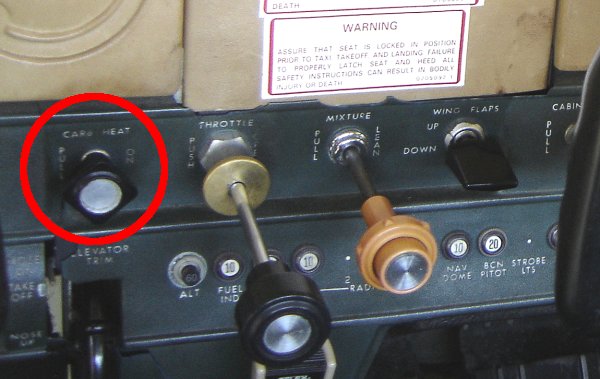So far, in my very brief flying career, I haven't thought much about carburetor ice or carburetor heat, other than as it pertains to decent and landing procedures (any time you reduce throttle in a C-150, or any time the engine is running below 2000 rpm, turn carb heat on).
And there was the various written materials and the tests, which contain questions like "what is the sign of carburetor ice in an airplane with a fixed-pitch prop", the correct answer to which is "a drop in engine rpm".
Those things provide one side of the equation; how to find carburetor ice if you know you're looking for it. After my flying experience yesterday, I think the other half of the equation should be added to flight training with a little more emphasis. That is, what should you do as a pilot to make sure that carburetor ice doesn't sneak up on you? The reason for this post is that I almost had an engine fail yesterday, and I'm pretty sure it was because I had bad carburetor icing and I didn't realize it until almost too late.
My new rule in flying: If the engine does something unexpected, particularly if it runs rough or the rpm drops unexpectedly, turn the carburetor heat on and leave it on for at least a minute or two. Codicils to this rule are as follows: - This is especially true when flying and airplane with a carburetor (not fuel injection). - This is especially true when flying and airplane powered by a Continental engine. - carb heat enrichens the mixture going into the engine. Therefore the one exception to this if you've flown from low to high altitude and forgot to lean the engine, it will already be running too rich, in which case carb heat will make the problem worse.
It takes several seconds for carb heat to take full effect. You can tell if you had carb ice because when the heat is applied, after a few seconds, the rpm drops a LOT but then climbs back up (after the ice is all melted).
Along with the last point: part of the run-up procedure for any piston-powered airplane is to test the carb heat by turning it on and making sure that the carb heat control works. I did that yesterday, and I definitely got a respose. However, thinking back, I think the rpm may have decreased more than usual--in retrospect, the airplane may have already been developing carb ice on the ground.
So as with most things, it's mostly a matter of being aware. For pilots, one thing to be very very aware of; the engine doing funny things can be a sign of carb ice, to which there is one and only one reasponse: pull the carb heat control and leave it there long enough to clear any ice.
And since I like pictures, here's my friend from yesterday:
